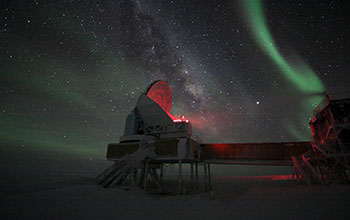Multimedia Gallery
Aurora over South Pole Telescope
Aurora australis ("southern lights") blankets the sky overhead of the 10-meter South Pole Telescope at Amundsen-Scott South Pole Station, Antarctica. The telescope collects data on cosmic microwave background radiation and black matter.
Like its more familiar counterpart, the aurora borealis, or "northern lights," the aurora australis is caused by the solar wind passing through the upper atmosphere. But the aurora australis is much less frequently observed because so few people live on Antarctica during the austral winter.
Amundsen-Scott South Pole Station is one of three U.S. research stations on the Antarctic continent. All of the stations are operated by the National Science Foundation's U.S. Antarctic Program (USAP). Further information about USAP is available Here. To learn more about the South Pole Telescope, visit the facility's website. (Date of Image: June 2008)
Credit: Dr. Keith Vanderlinde [Any commercial use of this image requires photographer's permission.]
See other images like this on your iPhone or iPad download NSF Science Zone on the Apple App Store.
Images and other media in the National Science Foundation Multimedia Gallery are available for use in print and electronic material by NSF employees, members of the media, university staff, teachers and the general public. All media in the gallery are intended for personal, educational and nonprofit/non-commercial use only.
Images credited to the National Science Foundation, a federal agency, are in the public domain. The images were created by employees of the United States Government as part of their official duties or prepared by contractors as "works for hire" for NSF. You may freely use NSF-credited images and, at your discretion, credit NSF with a "Courtesy: National Science Foundation" notation.
Additional information about general usage can be found in Conditions.
Also Available:
Download the high-resolution JPG version of the image. (1.6 MB)
Use your mouse to right-click (Mac users may need to Ctrl-click) the link above and choose the option that will save the file or target to your computer.

